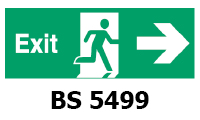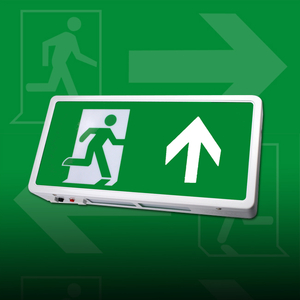Emergency Exit Signs - Clear Campaign
Emergency Exit Signs - Clear Campaign
It is not enough that a safety sign can be seen. It is essential that each sign is quickly understood and that an installation of signs quickly and clearly conveys their intention and continues to confirm the message.
Standardisation across Europe was one method of increasing a wider understanding of safety signs. Therefore, the EC Safety Signs Directive (92/58/EEC) was published and adopted as ‘The Health and Safety (Signs and Signals) Regulations’ in England during 1996. This piece of legislation set out simple ‘Pictogram’ sign formats to be used within the European Community.
The Regulations showed the intrinsic features required for emergency escape signs as being a white pictogram on a green background. The pictogram consists of the running man/arrow/door. These intrinsic features avoided the use of words in any of the escape signs and set out escape route guidance thereby simplifying the vast range of text signs that had previously been used. The only problem with the EC Safety Signs Directive was that the pictograms supplied were of a different format to those shown in ISO documents and some National Standards such as BS 5499. Here are the three formats currently available for use in the UK:

In 2011, it was decided by many of the National Standards bodies to consider adoption of a single pictogram format as shown in ISO 7010.
This format was adopted by BSI in the latest edition of BS5266: 2011 which is considered the ‘defacto’ emergency lighting standard in the UK. This is supported by the revised edition of EN 1838. BS 5499-4:2013 now gives guidance for externally illuminated signs. The requirements are identical irrespective of whether they are painted or phosphorescent: “the vertical illumination should be not less than 100 lux under normal lighting conditions and not less than 5 lux on any part of the face of the sign under mains-failure conditions.” Ref. clauses 5.2 and 5.4 of BS 5499-4:2013 The members of the Industry Committee for Emergency Lighting (ICEL) recognised that a further change in sign format could cause additional confusion within the already confused market and therefore decided to launch the ICEL Clear Sign Campaign.
It is a legal requirement for businesses to conduct risk assessments for fire safety and evacuation and it is of course vital that the emergency escape signs are of a legal format.
The current position includes the following key issues:
- Text only signs are not legal and should have already been replaced
- BS5499 Pictogram signs (with or without supplementary text) are legal but should only have been used when expanding an installation already incorporating similar signs.
- Pictogram only signs with the same format as shown in The Health and Safety (Signs and Signals) Regulations / EC Safety Signs Directive (92/58/EEC) are legal but should not be mixed with other sign formats on any installation.
- From 2012 the new ISO 7010 Pictogram signs will also be legal but again should not be mixed with other formats on an installation.
- The latest proposals do not only identify the ISO 7010 sign format, there are also references to ISO 3864-1, ISO 3864-3 and ISO 3864-4 to provide detailed information relating to the safety colour, contrast colour and dimensions of the elements.
These images show the different appearance of the Pictogram symbols used in these signs but the key differences between the Health and Safety (Signs and Signals) Regulations / EC Safety Signs Directive (92/58/EEC) pictograms and the ISO versions include:
- ISO 7010 details the pictogram as the running man which should be supported by a supplementary arrow sign. There is no blanket provision for the use of supplementary text signs to be used with an emergency exit sign.
- The only international standard which provides full guidance on the use of the arrows is ISO 16069 in which it states that ‘straight on’ is depicted by an arrow facing up. BS 5499-4:2013 now supports ISO 16069 in this respect whereas the Safety Signs and Signals Regulations and other ISO standards do not state which way the arrow should be used.

